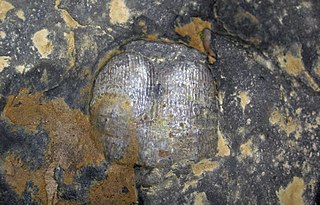The Treatise on Invertebrate Paleontology published by the Geological Society of America and the University of Kansas Press, is a definitive multi-authored work of some 50 volumes, written by more than 300 paleontologists, and covering every phylum, class, order, family, and genus of fossil and extant invertebrate animals. The prehistoric invertebrates are described as to their taxonomy, morphology, paleoecology, stratigraphic and paleogeographic range. However, taxa with no fossil record whatsoever have just a very brief listing.

Miacis is an extinct genus of placental mammals from clade Carnivoraformes, that lived in North America from the early to middle Eocene.
Paleontology or palaeontology is the study of prehistoric life forms on Earth through the examination of plant and animal fossils. This includes the study of body fossils, tracks (ichnites), burrows, cast-off parts, fossilised feces (coprolites), palynomorphs and chemical residues. Because humans have encountered fossils for millennia, paleontology has a long history both before and after becoming formalized as a science. This article records significant discoveries and events related to paleontology that occurred or were published in the year 2002.
Crurithyris is an extinct genus of brachiopod belonging to the order Spiriferida and family Ambocoeliidae.
Schizophoria is an extinct genus of brachiopod belonging to the superfamily Enteletoidea. Specimens have been found in Devonian through Permian beds in North America, Australia, central and southeast Asia, and eastern Europe.
Paleontology or palaeontology is the study of prehistoric life forms on Earth through the examination of plant and animal fossils. This includes the study of body fossils, tracks (ichnites), burrows, cast-off parts, fossilised feces (coprolites), palynomorphs and chemical residues. Because humans have encountered fossils for millennia, paleontology has a long history both before and after becoming formalized as a science. This article records significant discoveries and events related to paleontology that occurred or were published in the year 2022.
This list of fossil molluscs described in 2022 is a list of new taxa of fossil molluscs that were described during the year 2022, as well as other significant discoveries and events related to molluscan paleontology that occurred in 2022.
2022 in arthropod paleontology is a list of new arthropod fossil taxa, including arachnids, crustaceans, insects, trilobites, and other arthropods that were announced or described, as well as other significant arthropod paleontological discoveries and events which occurred in 2022.
Leiorhynchus is an extinct genus of brachiopod belonging to the order Rhynchonellida and family Leiorhynchidae. Specimens have been found in South America, North America, and Russia in beds of middle Devonian to Mississippian age. The genus may have been adapted to dysaerobic environments, colonizing areas of reduced oxygen concentrations rich in organic matter. The genus has been used as an index fossil in North America.
Beecheria is an extinct genus of brachiopod belonging to the order Terebratulida and family Beecheriidae. Fossils of this genus have been found in Mississippian to Permian beds in Eurasia, Australia, North America, and South America. The genus was part of the Levipustula fauna characteristic of cold water conditions. "Nests" of Beecheria have been found in fossil low temperature hydrothermal vent communities from the early Carboniferous in Newfoundland.
Diaphragmus is an extinct genus of brachiopod belonging to the order Productida and family Linoproductidae. Specimens have been found in Carboniferous beds in North America.

Marginifera is an extinct genus of brachiopod belonging to the order Productida. Specimens have been found in Carboniferous to Triassic beds in Asia, Europe, Madagascar, and North America.
Pugnoides is an extinct genus of brachiopod belonging to the order Rhynchonellida and family Petasmariidae. Specimens have been found in Devonian to Permian beds in North America, Asia, Europe, western Australia, New Zealand,and New Zealand. The genus was particularly widespread in the Visean.
This list of fossil molluscs described in 2023 is a list of new taxa of fossil molluscs that were described during the year 2023, as well as other significant discoveries and events related to molluscan paleontology that occurred in 2023.

Antiquatonia is an extinct genus of brachiopod belonging to the order Productida and family Productidae. Specimens have been found in Carboniferous beds across many continents, suggesting the genus had a cosmopolitan distribution. Species level taxonomy of Antiquatonia is in need of revision.


